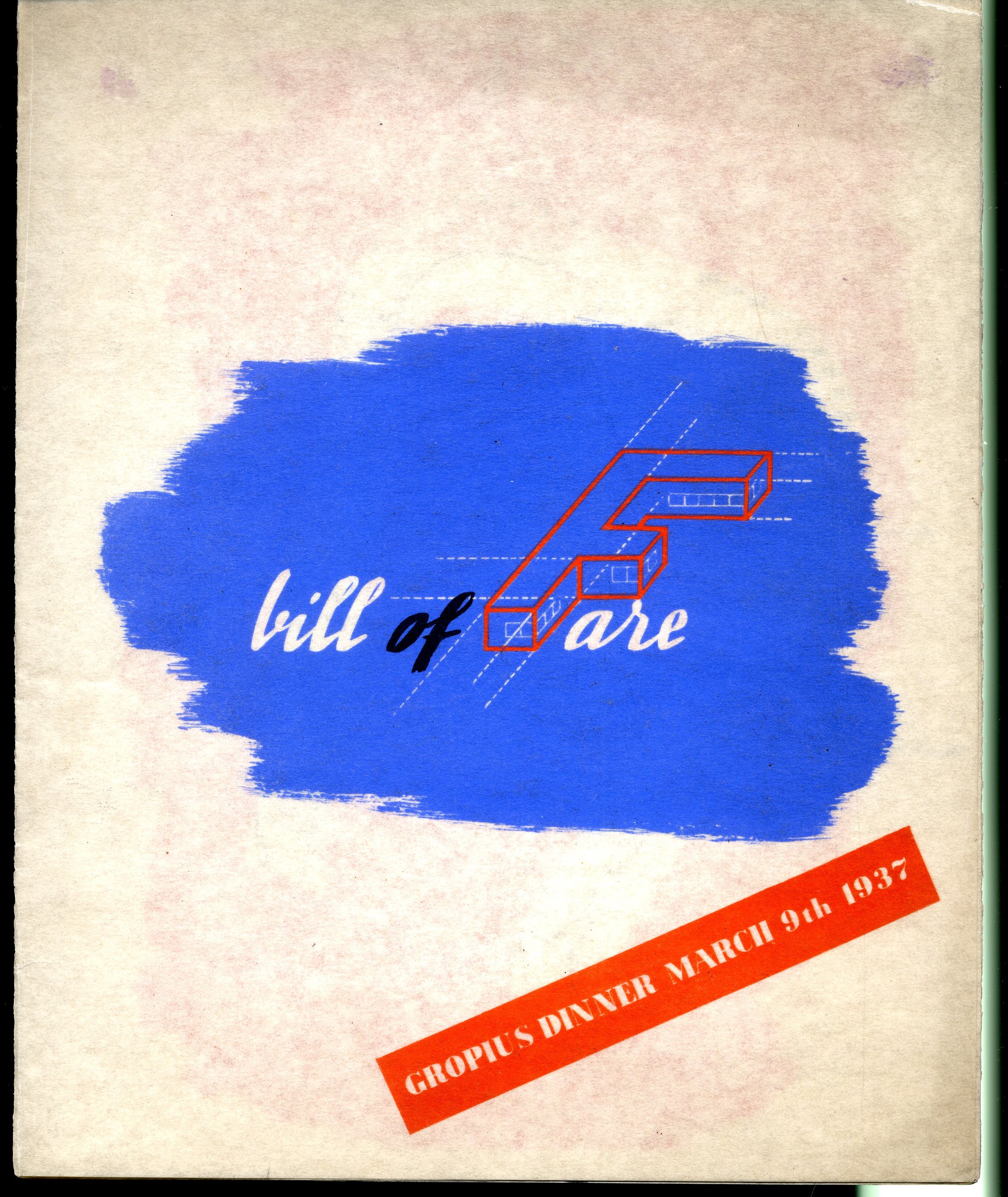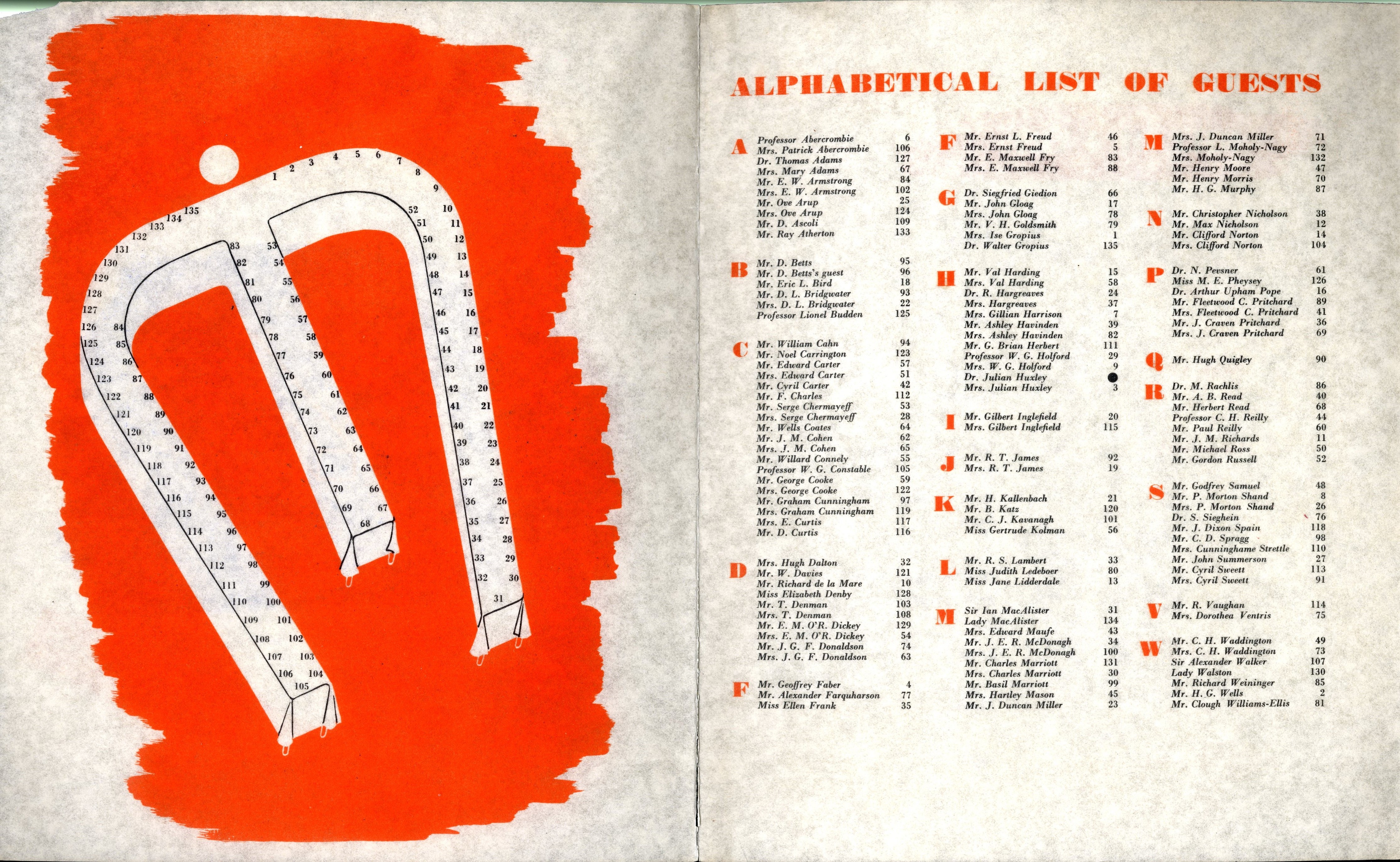Archive
Farewell Dinner for Walter Gropius
Farewell Dinner for Walter Gropius
Word Count: 5
- Dinner
- 09-03-1937
- 09-03-1937
Friends and colleagues came together on 9 March 1937 to send off the architect Walter Gropius and his wife Ise Gropius, who had decided to leave for the United States.
Word Count: 28

László Moholy-Nagy, Bill of Fare, farewell dinner menu for Walter Gropius, London, March 1937, front page (Pritchard Papers, University of East Anglia, © László Moholy-Nagy). 
László Moholy-Nagy, Bill of Fare, farewell dinner menu for Walter Gropius, London, March 1937 (Pritchard Papers, University of East Anglia, © László Moholy-Nagy). 
László Moholy-Nagy, Bill of Fare, farewell dinner menu for Walter Gropius, London, March 1937, Alphabetical List of Guests (Pritchard Papers, University of East Anglia, © László Moholy-Nagy). 
Portrait of Walter Gropius, London, c. 1937 (Pritchard Papers, University of East Anglia). This photo was included in the Bill of Fare farewell dinner menu for Walter Gropius designed by László Moholy-Nagy. Anker, Peder. The Bauhaus of Nature. Louisiana State University Press, 2005.
Burke, David. The Lawn Road Flats. Spies, Writers and Artists. The Boydell Press, 2014.
Daybelge, Leyla. “The Lawn Road Flats.” Insiders Outsiders. Refugees from Nazi Europe and their Contribution to British Visual Culture, edited by Monica Bohm-Duchen, Lund Humphries, 2019, pp. 165–171.
Daybelge, Leyla, and Magnus Englund. Isokon and the Bauhaus in Britain. Pavilion Books, 2019.
Powers, Alan. Bauhaus goes West. Modern Art and Design in Britain and America. Thames & Hudson, 2019.
Word Count: 78
Pritchard Papers, University of East Anglia.
Word Count: 6
My deepest thanks go to Bridget Gillies from University of East Anglia Archive for supporting me with images from the Pritchard Papers.
Word Count: 22
Trocadero Restaurant, 13–15 Coventry Street, Piccadilly Circus, London W1.
- London
- Burcu Dogramaci. "Farewell Dinner for Walter Gropius." METROMOD Archive, 2021, https://archive.metromod.net/viewer.p/69/1470/object/5141-7555508, last modified: 27-04-2021.
-
László Moholy-NagyPhotographerGraphic DesignerPainterSculptorLondon
László Moholy-Nagy emigrated to London in 1935, where he worked in close contact with the local avantgarde and was commissioned for window display decoration, photo books, advertising and film work.
Word Count: 30
Julian HuxleyZoologistPhilosopherWriterLondonJulian Huxley was the director of London Zoo from 1935 to 1942 and worked closely with emigrant photographers, artists and architects, including Berthold Lubetkin, Erna Pinner and Wolf Suschitzky.
Word Count: 27
Herbert ReadArt HistorianArt CriticPoetLondonThe British art historian Herbert Read established himself as a central figure in the London artistic scene in the 1930s and was one of the outstanding supporters of exiled artists.
Word Count: 30
Visual Pleasures from Everyday ThingsBookletLondonVisual Pleasures from Everyday Things is a booklet written in 1946 by the emigrated architectural historian Nikolaus Pevsner with the aim of aesthetic education and teacher training.
Word Count: 26
Isokon CompanyArchitecture and Furniture CompanyLondonThe furniture design and architecture company Isokon was an important commissioner for emigrants such as Marcel Breuer, Walter Gropius, László Moholy-Nagy, Ernst Riess and Edith Tudor-Hart.
Word Count: 27
Faber & FaberPublishing HouseLondonFaber & Faber shows the importance of publishing houses as supporters of contemporary art movements and of the contribution of emigrants, helping to popularise their art and artistic theories.
Word Count: 29